
The PS Lady Elgin was a wooden-hulled sidewheel steamship that sank in Lake Michigan off the fledgling town of Port Clinton, Illinois, whose geography is now divided between Highland Park and Highwood, Illinois, after she was rammed in a gale by the schooner Augusta in the early hours of September 8, 1860. The passenger manifest was lost with the collision, but the sinking of Lady Elgin resulted in the loss of about 300 lives in what was called "one of the greatest marine horrors on record". Four years after the disaster, a new rule required sailing vessels to carry running lights. The Lady Elgin disaster remains the greatest loss of life on open water in the history of the Great Lakes.
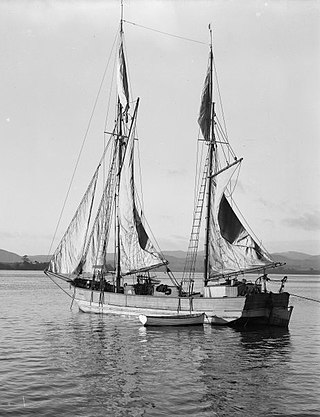
A scow is a smaller type of barge. Some scows are rigged as sailing scows. In the 19th and early 20th centuries, scows carried cargo in coastal waters and inland waterways, having an advantage for navigating shallow water or small harbours. Scows were in common use in the American Great Lakes and other parts of the U.S., Canada, southern England, and New Zealand. In modern times their main purpose is for recreation and racing; there are also garbage scows for aquatic transport of refuse.

The Seven Foot Knoll Light was built in 1855 and is the oldest screw-pile lighthouse in Maryland. It was located atop Seven Foot Knoll in the Chesapeake Bay until it was replaced by a modern navigational aid and relocated to Baltimore's Inner Harbor as a museum exhibit.

A steam donkey or donkey engine is a steam-powered winch once widely used in logging, mining, maritime, and other industrial applications.
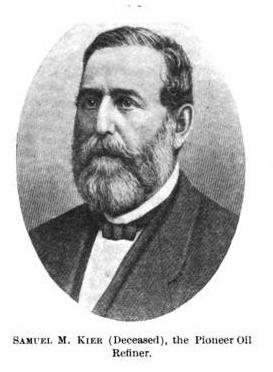
Samuel Martin Kier was an American inventor and businessman who is credited with founding the American petroleum refining industry. He was the first person in the United States to refine crude oil into kerosene lamp oil. Kier has been dubbed the Grandfather of the American Oil Industry by historians.

The New Richmond Swing Bridge, also known as the Fifty-Seventh Street Bridge, is a one lane swing bridge in Michigan. Located in Allegan County's Manlius Township, it connected 57th Street with Old Allegan Road over the Kalamazoo River until its closure to vehicular traffic. The name New Richmond comes from a former mining town in the area of the same name. The bridge is one of the oldest - if not the oldest - swing bridges extant in the United States, and is one of the oldest metal truss bridges in the state of Michigan and the state's longest pony truss bridge.

Old Mackinac Point Light is a deactivated lighthouse located at the northern tip of the Lower Peninsula in the U.S. state of Michigan. The lighthouse is part of Fort Michilimackinac State Park in the village of Mackinaw City just east of the Mackinac Bridge.
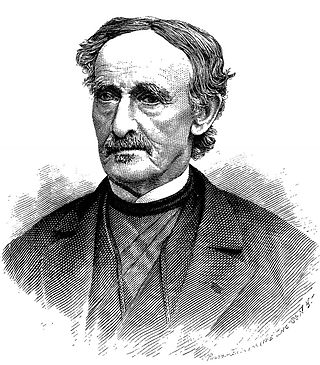
Joseph Francis was a 19th-century American inventor who devoted his life to improving maritime equipment, especially life-saving tools. His most famous invention, the metallic life-car, rescued thousands of stranded passengers and crew from shipwrecks near the shore.
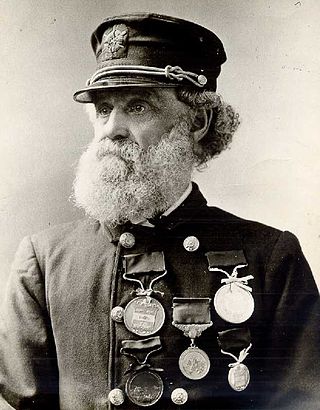
Joshua James was an American sea captain and a U.S. Life–Saving Station keeper. He was a famous and celebrated commander of civilian life-saving crews in the 19th century, credited with saving over 500 lives from the age of about 15 when he first associated himself with the Massachusetts Humane Society until his death at the age of 75 while on duty with the United States Life–Saving Service. During his lifetime he was honored with the highest medals of the Humane Society and the United States. His father, mother, brothers, wife, and son were also lifesavers in their own right.
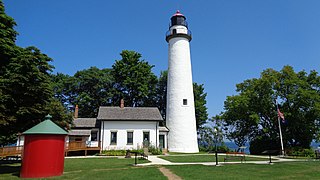
Pointe aux Barques Lighthouse is an active lighthouse located in Huron County in the U.S. state of Michigan. It is located along the shores of Lake Huron on the northeastern tip of the Thumb. Originally constructed in 1848, it is one of the oldest active lighthouses in the state. The name is translated as "point of little boats" from the French language, which refers to the shallow coastline that poses a threat to larger boats.

North Manitou Island Lifesaving Station, also known as North Manitou Coast Guard Station, is a complex of buildings located on North Manitou Island, which is part of Sleeping Bear Dunes National Lakeshore in Michigan, in the U.S. The complex was constructed as a life-saving station. It is the only remaining station which was in use during all three periods of lifesaving service history, from the early volunteer period through operation by the United States Life-Saving Service and the United States Coast Guard. It was declared a National Historic Landmark in 1998.
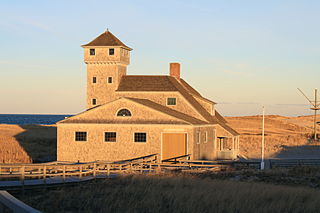
The Old Harbor U.S. Life Saving Station is a historic maritime rescue station and museum, located at Race Point Beach in Provincetown, Massachusetts. Built in 1897, it was originally located at Nauset Beach near the entrance to Chatham Harbor in Chatham, Massachusetts. It was used by the United States Life-Saving Service (USLSS), and then by its successor, the United States Coast Guard (USCG), as the Old Harbor Coast Guard Station. The station was decommissioned in 1944, abandoned and sold as surplus in 1947, and was used as a private residence for the next twenty-six years.
A rescue lifeboat is a boat rescue craft which is used to attend a vessel in distress, or its survivors, to rescue crew and passengers. It can be hand pulled, sail powered or powered by an engine. Lifeboats may be rigid, inflatable or rigid-inflatable combination-hulled vessels.

SS John B. Cowle was one of the early Great Lakes bulk freighters known as "tin pans". She was the first of two ships named for prominent Cleveland, Ohio citizen and shipbuilder John Beswick Cowle. In 1909 on her maiden voyage SS Isaac M. Scott rammed John B. Cowle in heavy fog off Whitefish Point. John B. Cowle sank in three minutes, taking 14 of her 24-man crew with her. Artifacts from her wreck were illegally removed in the 1980s. Her artifacts are now the property of the State of Michigan and are on display as a loan to the Great Lakes Shipwreck Museum. The wreck of John B. Cowle is protected as part of an underwater museum in the Whitefish Point Underwater Preserve.

The United States Coast Guard's series of motor lifeboats included a class of 36 foot motor lifeboats. The Coast Guard built the first of version these vessels in 1929, and retired the last active version, in 1987 as they were replaced by the 44 foot Steel Hull Motor Lifeboat. CG 36500 was retired from active service in 1968, and has since been restored and preserved as a floating museum. These vessels are remembered for the daring rescues Coast Guard seamen performed, using them.

The Montagu whaler was the standard seaboat of the Royal Navy between 1910–1970, it was a clinker built 27 by 6 feet open boat, which could be pulled by oars or powered by sail – a shorter version of 25 feet (7.6 m) was also built. It was double-ended; having a pointed stem and stern. Retired Rear Admiral The Honourable Victor Montagu proposed the design.

The Michigan Maritime Museum is a museum and research library located in South Haven in the U.S. state of Michigan. The museum is located next to the Dyckman Avenue bascule bridge on the Black River just in from Lake Michigan, the second-largest by volume of the five Great Lakes. The museum specializes in the maritime history of the state of Michigan and the lake of the same name.

The Sport was a tugboat, built in 1873 and wrecked in 1920 in Lake Huron. The wreck site, designated 20UH105, was listed on the National Register of Historic Places in 1992.

SS Senator was a steel-hulled Great Lakes freighter that sank on Lake Michigan with the loss of nine lives and 268 Nash automobiles, on Halloween of 1929 after she was rammed in heavy fog by the bulk carrier Marquette. She lies in 450 feet (140 m) of water 16 miles northeast of Port Washington, Wisconsin. On April 12, 2016 her wreck was listed on the National Register of Historic Places.



















